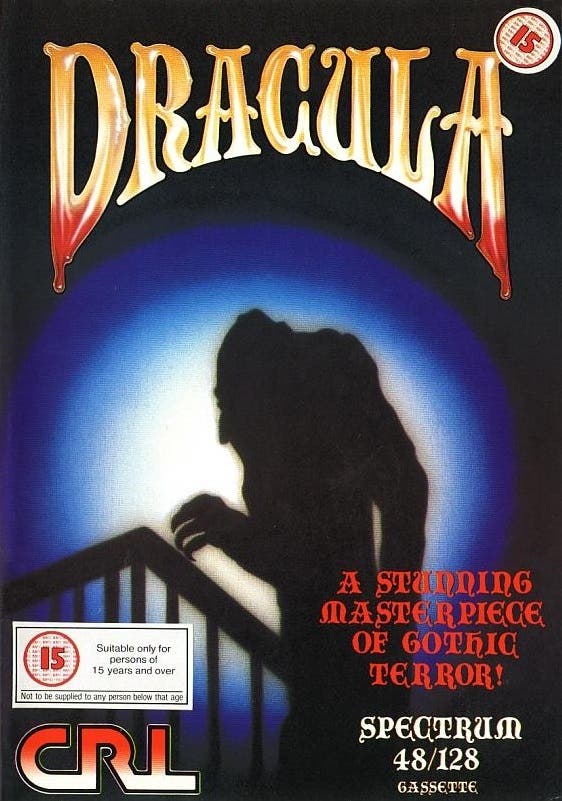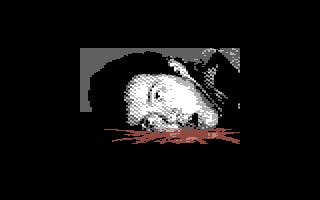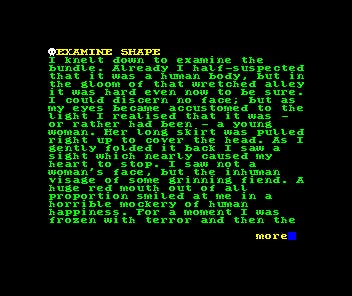Dracula unbound: The story behind the first 18 certificated video game
An undead cert.
In retrospect, it's a wonder no-one had thought of it before. In 1984 the incumbent Conservative government passed the Video Recordings Act; video nasties, a pet topic of those renowned moral guardians, the tabloid newspapers, were to become an endangered species. As the appointed adjudicators of who got to watch what, the British Board Of Film Classification suddenly became very busy people. It was now a legal requirement for all films and videos to carry a BBFC classification, unless they fell under the exempt category of either sport, music, religion or educational. Oh, and computer games didn't count either. Well, not really.
That's not to say by 1984 that computer games hadn't had their fair share of controversy. But generally the graphical ability and simple gameplay of contemporary games had rarely been seen as critical enough to warrant attention outside of the dedicated gaming press. Two years later, London-based software house CRL Group released a nondescript text adventure game for the Commodore 64 called Pilgrim. The game was unremarkable, and drew criticism for its lack of graphics at a time when even budget adventures were proudly showing off detailed vistas.

The one area Pilgrim did receive praise for was its atmosphere and story, the work of author and adventure game fan Rod Pike from East Anglia, who had sent the game to CRL on the off-chance it would publish it. "Pilgrim was a dark and gothic piece," says CRL founder Clem Chambers, "and we therefore logically thought, let's ask Rod to do a horror game."
Chambers, finely tuned to any possible money-making venture, had noticed a sub-clause in the video nasty act that suggested video games could be submitted to the BBFC for rating, should they be considered appropriately unsuitable for children. The proverbial light bulb lit up inside the CRL boss's head.
"Rod was a very normal guy, a lot older than us, but softly-spoken and grounded. He was really happy to work with us and was totally on board with the idea of going for a BBFC classification although I remember he was a little awed by my temerity. But that was about par for the course!"
With the added advantage of the quick turnaround for adventure games (most of the genre was still being designed with creative software package The Quill, albeit often with modifications), Pike was soon put to work adapting Bram Stoker's classic novel Dracula.
"We didn't interfere," says Chambers, "We just let him do his thing. Then we added the graphics." Michael Hodges was CRL's game development leader and Clem Chambers' right hand man. "I think it's fair to say most of us were horror film fans," remembers Hodges, "and when we got the chance to publish a game along those lines, we were all very happy. The idea to get a BBFC rating was brilliant." Hodges worked directly with Pike, who would send in versions of the game at various stages for CRL to test and suggest changes.
CRL used in-house artists to create the gory pictures that would accompany Dracula. These were essential for two reasons; firstly, text-only adventures were no longer viable commercially as consumers demanded graphics with their games. Secondly - and more importantly to CRL - if the game was to secure its coveted 18 certificate, then fittingly grisly graphic representations were vital. CRL's concept was to puncture Dracula's evocative scene-setting pictures with macabre and bloody images every time the player met an untimely demise, which, given the difficulty of the game, was often.

With the graphics done, Dracula was duly submitted by CRL to the BBFC for its consideration; what followed was not only a fascinating glimpse into the workings of the institution, but also the general attitude towards videogames at the time. "Once we had explained to the BBFC what we had created, they were keen to see it as they were worried that this was a new market that was developing," recalls Hodges. The CRL man spent several sessions at BBFC headquarters in London as he demonstrated the game and explained how it worked. "They were eager to learn, and we weren't keen on minors having access to the games. That was one of the main reasons for talking to them in the first place." The other reason was, of course, the publicity.
The BBFC's examiners comments to Dracula revealed a fear of children in particular being exposed to its lurid pictures. "Because the way in which the player loses is always by dying," one examiner noted, "it was felt to be unsuitable for persons under 15 who might find it frightening to lose several times in solitary play prior to bedtime." Of course, the majority of video games have the player essentially dying when losing. However, Dracula's graphic representations of such (including throat-slitting and impalement on fence spikes) were a far cry from exploding diminutive spaceship sprites or Miner Willy comically squashed under a Monty Python-esque foot.
"We will shortly be designing a new form for video games," stated the BBFC in a letter to CRL in October of 1986, while enclosing one of its existing video forms. The software house wedged Dracula as best as they could into the largely-irrelevant video submission forms and it was passed without cuts, and granted a 15 certificate, thus becoming the first BBFC-certified video game. Mission accomplished for CRL?
"We'd been pushing for an 18 certificate," admits Chambers, "as we reckoned the higher the certificate, the better the sales. Sadly, it was clear we needed animation for an 18 certificate." Despite the BBFC's reservations of the nation's youth being exposed to Rod Pike's vicarious written descriptions, the institution was still sensitive about censoring the written word. There was no doubt that Dracula's static images were enough to secure the minimum age-restriction (there was no '12' rating in 1986), but the desired 18 would remain out of CRL's reach. For now.

After a further 15-certificated effort from Rod Pike based on another classic novel, Frankenstein, CRL turned to developers St. Brides in an effort to finally obtain that 18 rating while Pike worked on his fourth game for the publisher. "St. Brides were nice people, but very unique," says Chambers of the Ireland-based developers. "I remember they dressed in Victorian garb and ran a pseudo-school for those who wanted to go back to school for a holiday. Very different!"
St. Brides had already created spoof adventures Bugsy and The Very Big Cave Adventure for CRL; Jack The Ripper would prove to be a surprising departure from the light-hearted developer. "St. Brides wanted in on the certificate idea," recalls Chambers, "and I think they wanted to go straight for the jugular, so to speak." Jack The Ripper, and to a lesser extent, Pike's Wolfman, hit the spot as far as the BBFC were concerned, although comments from the examiners once more betrayed their lack of experience with video games as well as fresh concerns over the games' content. "Rather an oddity this, in that it is a video game," states one of the reports in its opening statement on Jack The Ripper. "Basically a sort of role-playing game like dungeons and dragons."
Again, the game was demonstrated by CRL with each of its images shown to the examiners in the context of play. While the now-animated images were clearly 18-certificate level, the examiners still felt little need to censor the game and appeared more concerned with images of a sexual nature than violence, or those that combined the two elements. "The most explicit [image] is of a naked woman with her leg folded over to hide the pubic area," continues the same examiner, "however, even today these are undetailed realisations with no colour or toning that would make it into a picture that would give much erotic pleasure," before concluding 'there's really no erotic charge or nasty intent to justify our intervention beyond classifying 18'.
A second, again unattributed, report also gives reservations over Jack The Ripper's nudity while noting its colourful language. "We were worried initially of a graphic of a nude female torso with blood all over it and I'm not sure how acceptable this is in an entertainment game for the mass market. But otherwise [it] reads like a dungeons and dragons fantasy covered in flowery language with enough horror for an 18, although not to reject."

The passages from the game quoted by this second report seem tame by today's standards: "Suddenly I saw a hacked and bleeding body with blood dripping into a sacrificial cup," and "...while on the blood-soaked bed lay the body of a girl, her torso completely flayed," were both admitted by the examiner to sound 'worse than they read, the script more fairy tale than macabre horror, and the element of ghoulishness slight.'
The crucial point in both reports is the role the player takes in the game. Instead of playing the actual killer, the protagonist is falsely accused of the Ripper's crimes and must seek to clear their name. Rod Pike's Wolfman, granted an 18 certificate around the same time, gave the BBFC more pause for thought on this aspect as the player took on the role of the eponymous creature, bound by bloodlust to embark on a killing spree upon every full moon.
"We began the exercise looking at five images," said one examiner in their report. "They comprise three stills of victims with blood on their face, one of a couple embracing and a moving image of a victim with blood pouring out of her throat." The latter animated image gave the examiner the most cause for concern, but still only justified a 15 rating as he concluded it was more a 'series of stills than a movie shot.' Yet unlike Dracula and Jack The Ripper, the accompanying text and theme of the game gave the examiners more concern with Wolfman.
"It required the player to assume the identity of the werewolf killer," continues the examiner, "leading him on a series of instructions to enable him to commit a series of grisly murders, the results of which are flashed onto the screen, as a sort of reward. We are unsure whether to give this the sort of allowance normally given to literary text, or to unleash upon it the full vigour of the board's standards [against] the morally aversive contextualisation of violence, especially against women." The issue of a games player taking on the role of a random killer clearly has not abated since 1988, given the furore games such as Postal and Hatred still generate today.

Further comments reveal the BBFC still unsure how to treat video games, despite Dracula having been submitted two years earlier. A report initialled notes a necessity for high-level policy reviews on whether games should be censored at all, and what standards and principals should be applied since video games are 'neither this, video works, or that, books.'
The bespoke video game submission form is still notably absent, and yet while it's easy to judge this attitude as not taking the industry seriously, in 1988 the immersion and improved graphics of first-person shooters was still many years away, and a whole world of difference to CRL's literate adventures. But none of this concerned CRL which had secured its desired 18 certificates. And it worked; despite the BBFC's relatively relaxed approach to Jack The Ripper and Wolfman's material, the media went into predictable overdrive, fuelled in particular by the mythical status of the infamous serial killer.
"It was typical media moral panic," remembers Chambers, who freely admits to milking the pious indignation for all its worth. "The whole thing was classic situationism [a term used for media pranks or publicity stunts], even though I couldn't have told you what that was at the time. In fact, it was all more Barnum than Edgar Allen Poe." Even the usually tolerant games press got in on the act, although the sensationalist headlines were normally underlined with the correct suspicion that CRL were engineering the controversy in order to sell the game.
Despite the media attention, sales of CRL's horror games tapered off after Dracula, not helped by the age restriction and certain high-street chains refusing to stock them. "Graphic text adventures were going obsolete, just as text adventures before them," notes Chambers. In addition, CRL fell out with its distributor, Electronic Arts, effectively spelling the end of the company. But Chambers has no regrets and remains proud of creating the first BBFC rated games.
"I still feel very happy about it. It meant we had a hit and that meant we could make payroll. Payroll was the drumbeat we worked to because you were only ever 30 days away from disaster when you were self-funded as CRL was." But what of the horror adventures themselves - does Chambers feel any pangs of guilt at all at the accusation he was corrupting the nation's youth?
"I don't think anyone ever had a nightmare having played one of our games," he smiles. "You know, I once met Sir Christopher Lee and told him I'd spent my whole childhood having nightmares about him; he just looked me in the eyes and said 'Fairy tales, dear boy, fairy tales.' And compared to Sir Christopher Lee and his fangs, our games didn't even move the dial."









